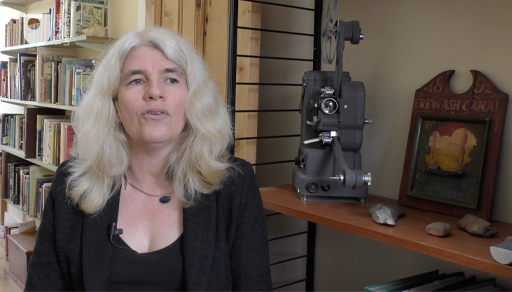4 Filming: some tips and tricks from a professional filmmaker
You are now going to focus on the technical aspects of the filmmaking process.
Activity 2
Watch Video 3, where professional filmmaker Gail Block shares some tricks of the filmmaking trade. Make some notes in the text box below on the kind of advice that you could pass on to young people for filming their docutubes. (Note that this is also a film you can show to your group before they start to film their docutubes.)

Transcript: Video 3
[MUSIC PLAYING]
[MUSIC PLAYING]
Discussion
In this film, Gail Block talks about a wide range of filming techniques including the following:
- Rehearse: encourage young people to rehearse first to find out what camera angle might work best and to rehearse any spoken words.
- Encourage them to film a number of different shots of the same scene/object, but from different angles.
- Encourage participants to try out a range of different filming techniques, including:
- Close-up shots where objects or people are filmed close to the camera, with focus on small details
- Establishing shots of landscapes, buildings, street names etc., to set the scene or give context
- Moving shots where the camera moves. This can convey a sense of dynamism.
- If interviews are included, film both the interviewee and the interviewer. If you only have one camera, you can always film the interviewer separately afterwards – edited together, no one will ever know the difference!
- Encourage participants to draw maps, charts, people or costumes that can be included in their films.
IN PRACTICE: Encouraging good filmmaking practices
Remind the groups to film a variety of shots and keep them short, working through the script they have developed in the ‘Plan’ phase of the workshop.
Advise them to delete obviously unsuccessful shots immediately from the camera, so as not to clutter the edit unnecessarily.

Here is some further advice from filmmaker Gail Block on what makes a good film shot:
- Composition: think about how you are framing what you are shooting in the frame – do you want a wide shot, showing context, or a closer shot showing the speaker’s facial expressions?
- Camera angle: consider using a tripod for stability.
- Sound: holding the camera close to the speaker also ensures sound is clear and the audience can hear what the speaker says. If a microphone can be connected to the camera, this can also help to give a more professional end result.
- Lighting: this can really bring a shot to life. You want to have what you are filming reflecting as much light as possible – point your light source at your subject, not at your camera (or move your subject into the light). Avoid filming against a window, the contrast in light levels means the speaker will be in silhouette.
